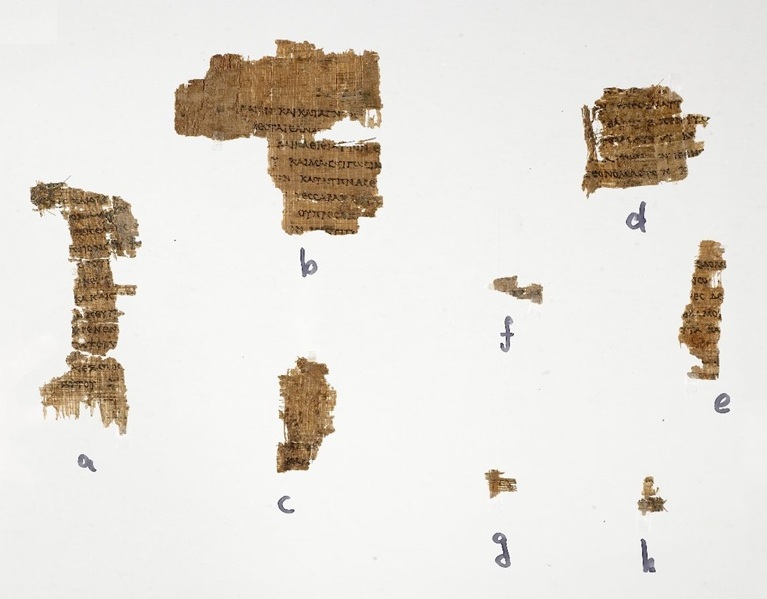by Dave Pocta -- San Antonio, Texas, USA
![Teachers' Corner BerkLOGO.jpeg [360x360] [288x288].jpg](https://images.squarespace-cdn.com/content/v1/533bf1b0e4b073f6c7fc73e1/1520089790371-OWY19SVYQ997R18PF4GK/ke17ZwdGBToddI8pDm48kLR91wanN1DY-mWerraBVdJZw-zPPgdn4jUwVcJE1ZvWhcwhEtWJXoshNdA9f1qD7Xj1nVWs2aaTtWBneO2WM-vd-r6kCRDLSj_w7d7aW8FcHiZzlwlc7V1dEcULr6yQyA/Teachers%27+Corner+BerkLOGO.jpeg+%5B360x360%5D+%5B288x288%5D.jpg)
When we open our bibles, we often take for granted what is in front of us. For centuries, scribes and scholars have meticulously unearthed ancient texts. They have preserved, catalogued, studied and compared them to accurately provide us with God’s Word. This paper is a very brief introduction to the languages, manuscript history, early translations, and textual criticism that laid the foundation for the blessing now known as the New Testament.
Biblical Languages
The original twenty-seven books of the New Testament were written in Greek. There are four major stages of the Greek language: classical, Koine, Byzantine, and modern. The New Testament was written in Koine, which was the common, everyday language of the time. Documents in the original language are called manuscripts and copies of them are transmissions. Documents in other languages are called versions as they are translations.
Languages vary in communication style, flow, and structure. We would therefore prefer to possess the earliest manuscripts in the original language to ensure accuracy and avoid the translators’ interpretation. The two extremes in translation would be “word for word” translations which tend to be more literal but often can lose the exact meaning of the text or “thought for thought” translations which attempt to capture the meaning but lose the nuances of specific words. This makes evident the difficulty in translating a translation. (I.e. Translating the New Testament from Latin into English introduces the difficulties of moving across two language barriers instead of translating from Greek directly into English.) The science of studying manuscripts to remove scribal copying errors and obtain the most likely original text is known as textual criticism. The intention of textual critics is to provide a precise original language text that can be used as a basis for translation into any language.
Manuscript History
As of the year 2005, we possessed over 5700 hand-written manuscripts that pre-date the 15th century (before the printing press). They are divided as follows:
Papyri 116 manuscripts
Majuscules 310 manuscripts
Minuscules 2877 manuscripts
Lectionaries 2432 manuscripts
Papyri were written on sheets made from the papyrus plant. They were less expensive than the other writing surfaces and were used until the 8th century. The papyri are the oldest remaining witnesses of the New Testament writings. The John Rylands fragment is a papyrus dated to around 125 A.D. and contains John 18:31-33, 37-38. If the Gospel of John was written in 85 A.D. as many suppose, this copy was written only forty years after the original!

Papyrus Greek 458. John Rylands Library, Manchester, UK.

Codex Vaticanus, 2 Thess. 3: 11-18
As Christianity became a legal and state-recognized religion in the 4th century, scriptoriums appear and more money became available through the churches to start copying the scriptures on parchment. Parchment was made from animal skins and vellum was the highest quality of parchment. It was from this period that we have the earliest codices, Codex Sinaiticus (4th century) and Codex Vaticanus (4th century). Codex Sinaiticus is the oldest remaining complete New Testament but the text is inferior to Codex Vaticanus due to some careless scribal errors. Vaticanus is superior in text form but is missing Hebrews 9:14 and onward. These manuscripts were written in capital letters and are called majuscules.
Around the 8th century, we begin to see copyists switch from majuscules to minuscules (Greek cursive). We also see the use of lectionaries appear more frequently. Lectionaries divided scripture into passages to be read during the liturgy. Different scripture was mapped out for different worship services. The minuscules and lectionaries were often ornately decorated.
Early Translations
Early versions of the New Testament begin to appear as early as 180 A.D. and were prepared by missionaries to help carry the gospel message to people that spoke different languages. These translations bring witness to the early text (2nd and 3rd century) but are used with care as the translator didn’t always have command of the Greek language.
We have disappointingly few early Latin manuscripts even though Tertullian often quoted the New Testament in Latin (he was believed to have translated his quotations directly from the Greek). We do know from Augustine (turn of 5th century) that many people obtaining Greek manuscripts would freely translate them into Latin, regardless of their knowledge of Greek. This provided a vast array of different Latin versions and prompted Pope Damasus in 382 A.D. to commission the church’s greatest Hebrew, Greek, and Latin scholar, Eusebius Sophronius Hieronymus (today known as St. Jerome) to create an authorized version for the church. He translated directly from the Hebrew to Latin for the Old Testament (putting aside the Septuagint) and compiled the most reliable Latin translations to compose the New Testament. This version became known as the Latin Vulgate.
Scholars have identified five major versions of the Syriac. The Syrian scholars were energetic and passionate about translating the gospel into their language. Manuscripts have been found from Lebanon, Egypt, Sinai, Mesopotamia, Armenia, India, and China! Other major early translations include Coptic, Gothic, Armenian, Georgian, Ethiopic, and Old Slavonic.
Textual Criticism
As the Greek manuscripts were copied as the church spread for general use, no universal standard existed to protect the process. Variants were introduced almost immediately and spread as these copies were copied. Obviously the early Christians had an extremely high regard for the transmission of these manuscripts but the human factor certainly came into play.
We do see different families of manuscripts developing in different geographic areas. By the 2nd century, the Western text appeared to be the loosest textual family as some paraphrasing was introduced. At the other extreme, the Alexandrian text represents a thorough and controlled exercise in the copying of manuscripts. This is not surprising as the city of Alexandria had a scholastic reputation. It was known for its completeness and lucid readings. When scholars look at the early manuscripts, they are often able to categorize the manuscripts based on these and other families.
How could variants be introduced into the text? There are many possibilities. Some variants were accidental and others were very deliberate. Accidental variants could include misspelling, leaving out words, repeating words, or skipping lines with similar endings. Deliberate variants generally were an attempt of the scribe to “correct” a perceived error. Scholars would sometimes “smooth out” bumpy variants; sometimes by conflation (combining the two variant readings into one) and sometimes by harmonizing divergent parallel passages. This happened primarily in the gospels.
The invention of the printing press reversed the increasing number of variants in the Greek text because now scholars could possess multiple manuscripts. Whenever a hand-written manuscript was copied, more opportunities for human error entered. These manuscripts were spread over thousands of miles so scholars were only able to look at a few of them at any given time. This would make it difficult to analyze them for the best reading. The printing press “froze” the text in time. Human error was no longer a factor. Manuscripts could be collected and printed so that scholars could compare many different readings. If the first 1400 years of textual transmission continued to introduce variants and weaken the text, our last 600 years have strengthened the text. Scholars have developed textual criticism to analyze variants and determine through external and internal evidence which would most likely be original. This process has brought us to a very reliable Greek text today.
Today’s Greek Bible
The first bible printed was a Latin version known as the Gutenberg bible somewhere between 1452 and 1456. In 1514, the first Greek bible was printed. In 1516, Erasmus, the great humanist of Rotterdam, published another version of the Greek text that became very famous. Unfortunately Erasmus relied on 12th and 13th century Byzantine manuscripts that had a poor text. He had earlier majuscules available to him but didn’t consult them! This version of the Greek text became known as the “Textus Receptus” or “received text.” It remained the text that scholars used for 300 years and was used to translate the King James Bible in 1611. Over the last 400 years, many significant discoveries have been made (including the discovery of Codex Sinaiticus) that have shed more light on the early Greek text of the New Testament. Today, two versions of the Greek text are used by scholars that reflect thorough textual criticism and scholarship; the 27th edition of Nestle-Aland and the 4th edition of the Greek New Testament (GNT - published by the United Bible Society and often called the UBS). The text of these is identical but the apparatus varies. The apparatus is all of the notes at the bottom of the pages that reference the various variant readings.
Modern translators of the New Testament use these texts as the basis for their work. We are blessed to have so many scholars that have worked so diligently to bring us such an accurate Greek text!

Gutenberg Bible
Bibliography
Aland, Kurt, and Barbara Aland. The Text of the New Testament. Grand Rapids: Eerdmans Publishing Company, 1995.
Bruce, F.F. The Canon of Scripture. Downers Grove: Intervarsity, 1988.
Jacoby, Douglas. How We Got the Bible. 2005.
Lightfoot, Neil R. How We Got the Bible. Third. Grand Rapids: Baker Books, 2003.
Metzger, Bruce M., and Bart D. Ehrman. The Text of the New Testament. New York: Oxford University Press, 2005.
Photo Credits
File:Codex Vaticanus B, 2Thess. 3,11-18, Hebr. 1,1-2,2.jpg
File:Gutenberg Bible, New York Public Library, USA. Pic 03.jpg,

